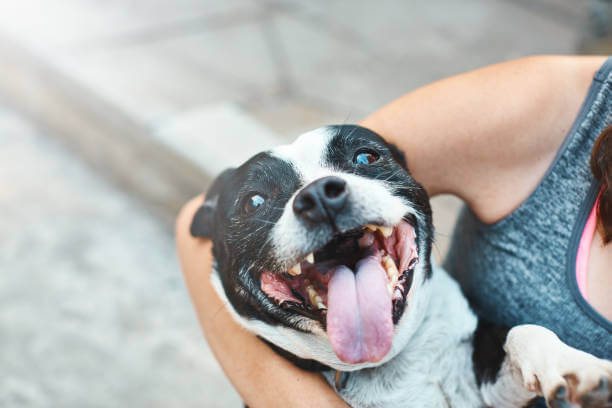
Have you ever wondered why dogs seem to grin when they’re happy? It’s not just your imagination; dogs do indeed smile! But what’s the secret behind those joyful grins? In this article, we will delve into the fascinating world of dog behavior to unveil the reasons behind their smiles.
Dogs smile as a form of communication. It’s their way of expressing happiness, contentment, and affection. When dogs smile, they often display their tongues and wag their tails, further indicating their joy.
But why do dogs smile? Well, for one, it’s an instinctive behavior passed down from their wolf ancestors. Wolves often bare their teeth to show submission and friendliness, and dogs have inherited this behavior. Additionally, dogs can also smile as a response to positive reinforcement and social interaction with their human companions.
Understanding why dogs smile is not only intriguing but also essential in building a strong bond with our furry friends. So, join us as we unravel the secrets behind their joyful grins and get a glimpse into the happiness they bring to our lives.
The Science Behind a Dog’s Smile
Dogs smile as a form of communication. It’s their way of expressing happiness, contentment, and affection. When dogs smile, they often display their tongues and wag their tails, further indicating their joy. But what goes on in a dog’s brain when they smile?
According to research, a dog’s smile is associated with the release of endorphins in their brain. Endorphins are neurotransmitters that create feelings of pleasure and happiness. When a dog is happy, their brain releases these chemicals, resulting in a smile-like expression.
Additionally, studies have shown that dogs have a remarkable ability to read human facial expressions. They can recognize when their human companions are happy and respond in kind by smiling. This ability to understand and mirror our emotions strengthens the bond between dogs and humans.
Understanding dog body language is crucial in interpreting their smiles accurately. Let’s explore this further in the next section.
Understanding Dog Body Language

Dogs communicate primarily through body language, and their smiles are just one aspect of it. To understand why dogs smile, we need to interpret their overall body language.
When a dog is happy, their body language is relaxed and open. They may have a soft gaze, a loose wagging tail, and relaxed ears. Their mouth may be slightly open, resembling a smile. It’s important to note that a dog’s smile should not be confused with bared teeth, which can indicate aggression or fear.
In addition to their mouth, a dog’s eyes also play a significant role in their expressions. A happy dog will have relaxed, bright eyes that convey joy and contentment. Understanding these subtle cues can help us better understand our furry friends and their smiles.
Reasons Why Dogs Smile
Now that we understand the science behind a dog’s smile and how to interpret their body language, let’s explore the reasons why dogs smile.
One reason dogs smile is rooted in their evolutionary history. Dogs are descendants of wolves, and wolves often bare their teeth as a sign of submission and friendliness. This behavior has been passed down through generations, and dogs have retained this instinctive way of expressing happiness.
Another reason dogs smile is in response to positive reinforcement and social interaction with their human companions. Dogs are social animals, and they thrive on human interaction and attention. When they receive love, praise, and treats, they often respond with a smile. It’s their way of showing gratitude and happiness.
Additionally, dogs may also smile when they are engaged in activities they enjoy, such as playing fetch, going for a walk, or receiving belly rubs. These moments of joy and excitement can bring a smile to their faces, just like they bring happiness to ours.
The Role of Socialization in a Dog’s Happiness

Socialization plays a crucial role in a dog’s happiness and, consequently, their ability to smile. Dogs are pack animals by nature, and they thrive in social environments. Proper socialization from an early age helps them develop the necessary skills to interact with other dogs and humans, leading to a happier and more confident demeanor.
When dogs are well-socialized, they are more likely to experience positive interactions with others, leading to increased opportunities for smiles. Socialization also helps dogs develop emotional resilience, allowing them to handle new experiences and environments without fear or anxiety.
As responsible dog owners, it’s our duty to provide our furry friends with ample opportunities for socialization. This includes exposing them to different people, animals, and environments in a controlled and positive manner. By doing so, we contribute to their overall well-being and happiness.
The Connection Between a Dog’s Smile and Their Overall Well-being
A dog’s smile is not just a superficial expression of happiness; it is closely tied to their overall well-being. When a dog is happy, their physical and mental health improves, leading to a better quality of life.
Studies have shown that happy dogs are less likely to develop behavioral problems such as aggression or separation anxiety. They are also more likely to have a healthy appetite, maintain a healthy weight, and have a stronger immune system.
Furthermore, a dog’s smile is contagious. When we see our dogs smiling, it brings us immense joy and happiness. This positive emotional connection between humans and dogs has been shown to release oxytocin, a hormone associated with bonding and stress reduction. The simple act of seeing our dogs smile can have a profound impact on our own well-being.
Tips for Making Your Dog Smile More

Now that we understand the importance of a dog’s smile and its connection to their well-being, let’s explore some tips for making your dog smile more.
1. Spend quality time together: Dogs thrive on attention and love. Dedicate regular quality time to play, cuddle, and engage in activities your dog enjoys. This will strengthen your bond and bring more smiles to both of your faces.
2. Provide mental stimulation: Dogs are intelligent creatures that need mental stimulation to keep their minds sharp and happy. Incorporate puzzle toys, interactive games, and training sessions into your daily routine to challenge your dog’s mind and promote happiness.
3. Create a positive environment: Dogs are highly perceptive to their surroundings. Ensure your home is a safe and positive environment by providing comfortable bedding, a balanced diet, regular exercise, and plenty of opportunities for socialization.
4. Use positive reinforcement: Reward your dog’s good behavior with treats, praise, and affection. Positive reinforcement helps reinforce positive behaviors, making your dog more likely to smile and display happy expressions.
By implementing these tips, you can create an environment that promotes your dog’s happiness and encourages more smiles.
Common Misconceptions About a Dog’s Smile
Despite the joyous nature of a dog’s smile, there are some common misconceptions that need to be addressed.
One misconception is that all dogs smile in the same way. While many dogs display a similar expression when they smile, it’s important to remember that each dog is unique. Some dogs may have a more pronounced smile, while others may have subtle variations in their expression.
Another misconception is that a dog’s smile always indicates happiness. While a smile is generally associated with happiness, it’s essential to consider other aspects of a dog’s body language to accurately interpret their emotions. Factors such as tail wagging, ear position, and overall body posture should be taken into account.
Understanding these misconceptions allows us to appreciate the complexity of a dog’s emotions and expressions and avoid misinterpreting their smiles.
Capturing Your Dog’s Smile: Photography Tips and Tricks

As dog owners, we always want to capture those precious moments when our furry friends smile. Here are some photography tips and tricks to help you capture the perfect shot of your dog’s smile:
1. Natural lighting: Photograph your dog in natural light to capture the true colors and details of their smile. Avoid using flash, as it can startle or irritate your dog.
2. Get down to their level: To capture the genuine joy in your dog’s smile, get down to their eye level. This perspective will create a more intimate and authentic photograph.
3. Use treats and toys: Entice your dog with treats or their favorite toy to capture their attention and evoke a smile. This will create an engaging and joyful expression in your photographs.
4. Patience is key: Dogs can be unpredictable, so be patient and ready to capture the perfect moment. Keep your camera or smartphone ready, and be prepared to take multiple shots to capture that infectious smile.
Remember, the most important thing is to enjoy the process and have fun with your furry friend. The genuine happiness and love between you and your dog will shine through in your photographs.
The Impact of a Dog’s Smile on Human Happiness
Dogs have a remarkable ability to bring joy and happiness into our lives, and their smiles play a significant role in this. When we see our dogs smiling, it triggers a positive emotional response in us.
Numerous studies have shown that interactions with dogs can reduce stress, lower blood pressure, and increase feelings of happiness and well-being. The simple act of seeing our dogs smile can lift our spirits and remind us of the joy and love they bring into our lives.
Additionally, dogs provide companionship and unconditional love, which can help combat feelings of loneliness and depression. Their smiles serve as a constant reminder of the happiness and comfort they provide us, making our lives richer and more fulfilling.
Conclusion: Celebrating the Joy and Happiness Dogs Bring With Their Smiles
Dogs have an incredible ability to bring joy and happiness into our lives, and their smiles are a testament to that. Whether it’s a subtle expression or an ear-to-ear grin, a dog’s smile is a powerful communication tool that conveys happiness, love, and contentment.
Understanding the reasons behind a dog’s smile allows us to deepen our bond with them and create a more fulfilling and joyful relationship. By providing them with love, attention, and opportunities for socialization, we contribute to their overall well-being and happiness.
So, the next time you see your furry friend smiling, take a moment to cherish that precious expression. Celebrate the joy and happiness dogs bring into our lives with their infectious grins. After all, a dog’s smile is a reminder of the unconditional love and unwavering loyalty they offer us every day.
